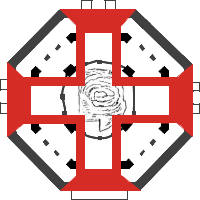Order of Christ Cross
a Templar Cross

Religious Jewish scholars believe that the Ark of the Covenant was placed on a rock in the Holy of Holies of Solomon's Temple (the First Temple) in Jerusalem. That slab of rock is also believed to be the first bit of earth that God created and from which the rest of the planet was formed.

Dome of the Rock, Jerusalem
It is now covered by a mosque known as the Dome of the Rock and Muslims believe that this same rock is the location where Muhammad ascended to heaven.
For Christians, this is the location of the Church of St. Cyrus and St. John, built by Constantine's mother.
Small wonder that this has been the focal point of many conflicts (see Jerusalem Cross). During the First Christian Crusades the Knights established their church and headquarters here in the captured Al Aqsa Mosque. They renamed it the Temple of Solomon (from the temple built in the 10th century BC by King Solomon) and from that the Knights took their name of 'Templar'. The structural layout of the church became the blueprint for Templar churches across Europe.
They were an impressive bunch of lads; strong, and considered by kings and rulers to be righteous. They enjoyed privileges not dissimilar to today's Western military forces; passing freely across borders and collecting taxes for themselves rather than paying them. With the backing of the Church, they were able to collect funds for their own development.
In 1139 Pope Innocent II decreed that the Templars were answerable only to him and therefore not required to observe local laws. In practice, this meant the Knights were a law unto themselves. They established churches, vineyards, strong business and banking networks, factories and various industries. 'Templar Inc.' became a formidable international commercial and banking force, still controlled today to some extent by their descendants in Masonic lodges.
Understandably the power of the Knights irked the ruling classes and eventually the Church was forced to dissolve the Order and seize their assets.

São Paulo
One of the organization's stronger outposts was in Portugal, and it is there we see one of the Templar Crosses. When the Templars were abolished, the Orders in Portugal changed their name to the Knights of Christ; hence the symbol's name Order of Christ Cross. This was proudly flown from the masts of Portuguese ships during their colonising expeditions, expanding their control and influence from Europe to many other parts of the world.
In 1500 Pedro Álvares Cabral 'discovered' Brazil and he was followed in 1554 by Jesuit priests Manuel da Nóbrega and José de Anchieta who built a mission named Colégio de São Paulo de Piratininga (Mission of St. Paul). On that spot now stands the city of São Paulo and the Order of Christ Cross is the main feature of the city's flag. (The Latin motto in the flag's centre is the defiant Non ducor, duco - 'I am not led, I lead'.)
The similarity between the Order of Christ Cross on the São Paulo flag and the Maltese Cross with its pattee arm ends is clear.
 However, there is another theory about the origin of the design. And for that we need to trace our steps back to the Dome of the Rock and look at the structural layout of the building. |
 Taking an imaginary line from the four central pillars to the outer pillars forms a Greek Cross |
  Order of Christ Cross Extending the tips of the cross to the corners of the dome gives us the same angles and proportions of the Order of Christ Cross. Superimposing the cross on the layout we see the centre of the cross is over the Rock of Temple Mount. St. Peter is known as 'The Rock', alluding to his being the foundation of the Christian Church. (The old Greek for 'Peter' is Petros and the old Greek for 'rock' is similarly pronounced petra. Presumably Jesus spoke to Peter in Aramaic where both 'Peter' and 'rock' are kepha.) The arms of the cross stretch out to the edges of the dome, just as the Christian's duty is to spread the Gospel to the edges of the world. |
The connection between the Knights Templar and this Cross Pattée style can therefore be traced back to the time of Pope Innocent II.
See also the Calatrava Cross
Jesus calling Peter the rock upon which the Church would be built Matt. 16:18
A few years later, Pope Eugene III also granted the Knights the Cross of Lorraine

